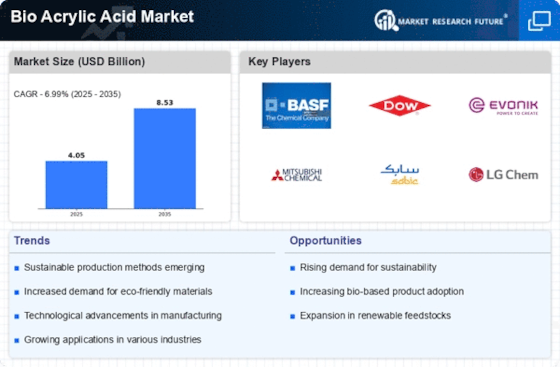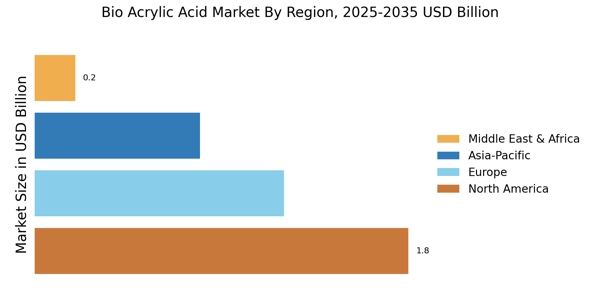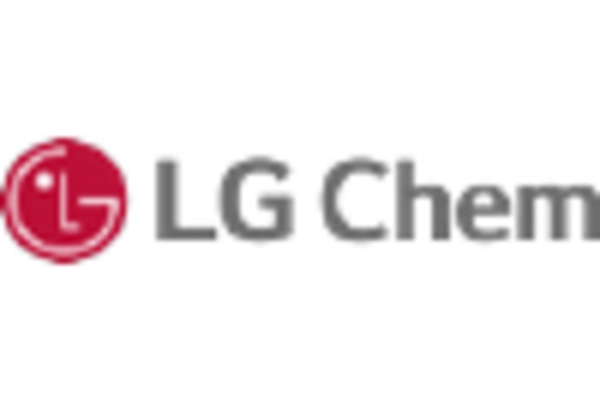Consumer Awareness and Education
Growing consumer awareness regarding the environmental impact of traditional chemicals is a vital driver for the Bio Acrylic Acid Market. As consumers become more educated about the benefits of bio-based products, their purchasing decisions increasingly favor sustainable options. This shift is evident in the rising demand for products labeled as eco-friendly or biodegradable, which often include bio acrylic acid. Market trends indicate that consumer preference for sustainable products is influencing manufacturers to reformulate their offerings, thereby increasing the availability of bio acrylic acid in the market. Furthermore, educational campaigns by environmental organizations are further amplifying this trend, leading to a projected increase in bio acrylic acid consumption by approximately 8% annually. This heightened consumer awareness is likely to play a pivotal role in shaping the future of the Bio Acrylic Acid Market.
Supportive Regulatory Frameworks
The establishment of supportive regulatory frameworks is a crucial driver for the Bio Acrylic Acid Market. Governments across various regions are implementing policies that promote the use of bio-based chemicals, including bio acrylic acid. These regulations often include incentives for manufacturers to adopt sustainable practices and reduce carbon footprints. For example, certain regions have introduced tax breaks and subsidies for companies that invest in bio-based production technologies. This regulatory support not only encourages investment in the bio acrylic acid sector but also fosters innovation and research in sustainable chemical production. Market data indicates that regions with strong regulatory backing for bio-based products are witnessing a growth rate of approximately 15% in the bio acrylic acid segment, highlighting the positive impact of these policies on the Bio Acrylic Acid Market.
Innovations in Production Technologies
Technological advancements in the production of bio acrylic acid are significantly influencing the Bio Acrylic Acid Market. Innovations such as fermentation processes and the use of renewable feedstocks are enhancing production efficiency and reducing costs. For instance, recent developments in biotechnological methods have enabled the conversion of biomass into bio acrylic acid with higher yields and lower energy consumption. This shift not only improves the economic viability of bio acrylic acid but also aligns with the growing emphasis on sustainable manufacturing practices. Market analysis suggests that these technological innovations could lead to a reduction in production costs by up to 20%, thereby making bio acrylic acid more competitive against conventional acrylic acid. As a result, the Bio Acrylic Acid Market is likely to experience accelerated growth driven by these advancements.
Rising Demand for Eco-Friendly Products
The increasing consumer preference for sustainable and eco-friendly products is a primary driver of the Bio Acrylic Acid Market. As awareness of environmental issues grows, industries are shifting towards bio-based alternatives. This trend is particularly evident in sectors such as textiles, paints, and adhesives, where bio acrylic acid serves as a renewable substitute for traditional acrylic acid derived from fossil fuels. Market data indicates that the demand for bio-based chemicals is projected to grow at a compound annual growth rate of over 10% in the coming years, reflecting a significant shift towards sustainability. Consequently, manufacturers are investing in bio acrylic acid production to meet this rising demand, thereby enhancing their market presence and contributing to the overall growth of the Bio Acrylic Acid Market.
Expanding Applications Across Industries
The versatility of bio acrylic acid is driving its adoption across various industries, thereby propelling the Bio Acrylic Acid Market. Applications range from coatings and adhesives to textiles and personal care products. The increasing use of bio acrylic acid in the automotive and construction sectors, where it is utilized for its adhesive properties and durability, is particularly noteworthy. Market Research Future suggests that the construction industry alone is expected to account for a significant share of the bio acrylic acid market, with a projected growth rate of around 12% over the next few years. This expansion into diverse applications not only broadens the market scope but also enhances the overall demand for bio acrylic acid, reinforcing its position within the Bio Acrylic Acid Market.


















Leave a Comment